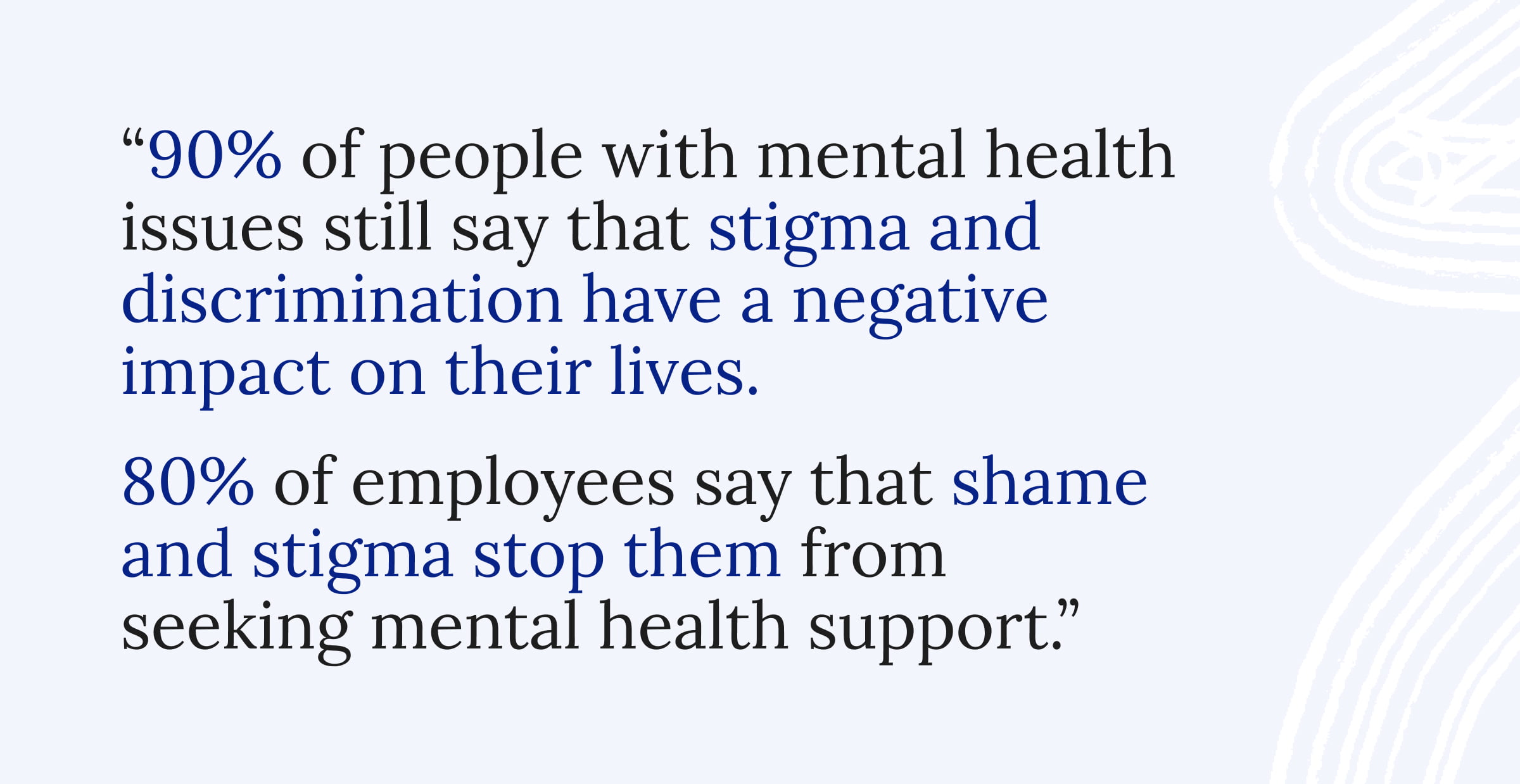Most managers understand: mental health is crucial. All scientific and medical advice shows that employees can only thrive in a mentally healthy, psychologically safe workspace.
But knowing that mental health is important and making sure you’re looking after your employees are two separate things. And there are a number of real challenges facing leaders who want to prioritize employee well-being.
But knowledge is power. In this article, we’ll break down the biggest challenges around mental health in the workplace, as well as suggestions for counter-strategies you can implement in your organization. Let’s get started!

Lack of leadership training and development
Mental health is a massive topic, and one challenge surrounding it is misinformation or simple lack of knowledge. Most leaders won’t have experience in psychological safety or taking care of other people’s mental health — and that’s totally okay!
But it needs to be a priority in your organization to develop your leadership team and give them the resources they need to help their employees.
Don’t leave your leaders (or yourself) struggling with no idea how to help. Instead, equip them to help with strategies like:
- Training for leaders and managers on recognizing signs of mental health issues and appropriate responses.
- Establishing peer support networks for leaders to share experiences and strategies.
- Providing specific programs, like nilo.health’s leadership training, which support and empower your leaders in building psychologically safe teams and workplaces.
Limited resources and accessibility issues
While leaders may want to help and encourage employees to seek therapy and other mental health support systems to boost their well-being, another challenge facing leaders is that times are tight.
Therapy continues to be worryingly inaccessible for many people, whether because they can’t afford it or because waiting lists are long in many cities and countries around the world. Companies who want to provide their employees with these mental health resources might also worry that there’s no room in their budgets for this kind of expense.
However, economic struggles can be overcome. And you’ll find they pay off: leaders who take good care of their team’s mental well-being see a 5x return on their investment. To tackle resource and accessibility issues, consider strategies like:
- Investing in an all-in-one platform, like nilo.health, which provides every element of mental health support your team needs without having to subscribe to multiple different tools.
- Measuring performance and productivity metrics pre- and post-mental health support for your employees, to better understand and value the business case behind mental health support.
Mental Health Stigma
Mental health stigma is still a real and present issue in modern workplaces. We’ve come a long way in terms of the way we understand mental health, but a massive 90% of people with mental health issues still say that stigma and discrimination have a negative impact on their lives. 80% of employees say that shame and stigma stop them from seeking mental health support.
Even leaders who believe in the importance of mental health might unknowingly contribute to mental health stigma, for example by feeling too shy or self-conscious to talk about it at work.

That means the most important step leaders can take against this challenge is to break the silence. Try tactics like:
- Implementing training programs or discussion opportunities that educate employees about mental health, aiming to normalize conversations and reduce stigma.
- Openly discussing your own mental health, sharing your experiences where appropriate to demonstrate vulnerability and acceptance.
- Developing and promoting policies that protect employees who seek mental health support, ensuring confidentiality and non-retaliation.
Remote work and isolation
The COVID-19 pandemic revolutionized the way we work. In many ways, this was an improvement for employees; many of us value the flexibility and efficiency of remote work.
However, the isolation that arises as a result of remote work is also one of the biggest challenges facing leaders around mental health support, because it is so prevalent and so hard to track.
There are multiple ways to support your remote team members, with tactics like:
- Implementing remote-friendly mental health support resources, like online one-to-one sessions with psychologists and roundtable discussions across multiple timezones, which offer a way to manage mental health remotely.
- Encourage employees to set clear work-life boundaries, such as defined working hours and regular breaks.
- Scheduling regular virtual check-ins and virtual activities to maintain connection, support, and team building among your remote employees.
The struggle to build a supportive culture
A strong and healthy company culture is one of the best ways to support your employees’ well-being. But building that strong company culture is no easy feat, and it requires a long-term, strategic and holistic strategy to create the kind of company that makes employees happy to work there — boosting retention and performance along the way.
To create a supportive culture that prioritizes mental health, consider strategies like:
- Integrating mental health and well-being into the organization’s vision and values.
- Developing inclusive practices that consider the diverse mental health needs of all employees.
- Providing ongoing support through initiatives like wellness programs, peer support groups, and mental health champions within the organization.
Performance and productivity issues
High-performance cultures can sometimes conflict with mental health initiatives, as the emphasis on productivity may lead to excessive stress and burnout. Balancing performance expectations with well-being is a significant challenge for leaders.
But ultimately, valuing performance and productivity over employee well-being is unsustainable, because high rates of turnover and poor engagement will lead to less productivity and higher costs for your company.
To embrace a company culture that values both performance and mental health, implement tactics like:
- Setting realistic performance goals that consider employees’ mental health and well-being.
- Monitoring workloads and redistributing tasks as necessary to prevent burnout.
- Recognizing and rewarding not only performance but also healthy work practices and behaviors.
- Implementing preventative care opportunities to stop stress issues before they build to a crisis.
The biggest support for the biggest challenges
One thing you’ll notice about all of these challenges facing leaders today is that implementing mental health support can help in every single case.
A mental health support tool like nilo removes stigma, trains your leaders, provides the resources and access your team needs, and boosts your company culture for every employee (remote or not!), while also boosting business performance and productivity.
That means that mental health support is the key resource your leaders need. Want to find out more? Let’s talk.







